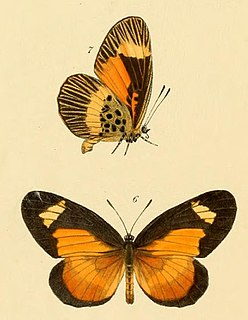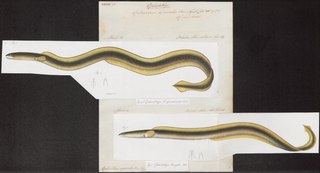
The lesser stick-nest rat or white-tipped stick-nest rat is an extinct species of rodent in the Muridae family. It lived in central Australia where it built nests of sticks that accumulate over years and can become very large. The last confirmed sighting of this rat was in 1933 although there is a credible report of a sighting in 1970. In 2008, the International Union for Conservation of Nature listed it as "critically endangered", suggesting that it may yet survive in remote areas of unsurveyed territory, but revised its evaluation to "extinct" again in 2016, based on an assessment in 2012.

Dibbler is the common name for Parantechinus apicalis, an endangered species of marsupial. It is an inhabitant of the southwest mainland of Western Australia and some offshore islands. It is a member of the order Dasyuromorphia, and the only member of the genus, Parantechinus. The dibbler is a small, nocturnal carnivore with speckled fur that is white around the eyes.
The Andean rat is the only species in the genus Lenoxus. It is a rodent in the tribe Akodontini found on the eastern slopes of the Andes of eastern Peru and western Bolivia.
Nectomys is a genus of rodent in the tribe Oryzomyini of family Cricetidae. It is closely related to Amphinectomys and was formerly considered congeneric with Sigmodontomys. It consists of five species, which are allopatrically distributed across much of South America: Nectomys magdalenae in montane Colombia; Nectomys palmipes on Trinidad and in nearby Venezuela, Nectomys apicalis in the western margins of the Amazon biome, Nectomys rattus in much of Amazonia, and Nectomys squamipes in the Atlantic Forest of Brazil.

The inland thornbill, called the broad-tailed thornbill, is a small, insect-eating bird of Australia. The inland thornbill is commonly confused with the coastal brown thornbill due to its similar colorations. The inland thornbill encompasses four subspecies:

The apical flycatcher is a species of bird in the family Tyrannidae.
Nectomys apicalis, also known as the western Amazonian nectomys, is a semiaquatic species of rodent in the genus Nectomys of family Cricetidae. It is found east of the Andes in Ecuador, Peru, and Bolivia, east into western Brazil; further to the east, it is replaced by N. rattus. It lives near watercourses in lowland tropical rainforest. Its karyotype has 2n = 38-42, and it probably actually represents several distinct undescribed species.
Copelatus apicalis is a species of diving beetle. It is part of the genus Copelatus of the subfamily Copelatinae and the family Dytiscidae. It was described by Fairmaire in 1898. Copelatus apicalis is distributed along the coastline of much of Africa.

Mimacraea apicalis, the central acraea mimic, is a butterfly in the family Lycaenidae. It is found in Nigeria, Cameroon, Gabon and the Republic of the Congo.

Dindicodes apicalis is a moth of the family Geometridae first described by Frederic Moore in 1888. It is found in Asia, including India and China.

Vestalis apicalis, or the black-tipped forest glory, is a species of damselfly belonging to the family Calopterygidae. It is found in India and Sri Lanka.

The bluntnose snake-eel is an eel in the family Ophichthidae. The author of the species is anonymous, but it has been referred to Edward Turner Bennett in 1830. It is a tropical, marine eel which is known from the Indo-Pacific, including Kenya, Madagascar, South Africa, Taiwan, Thailand, and the Philippines. It dwells at a maximum depth of 22 m, but also frequents shores. Males can reach a maximum total length of 45 cm.

Sybra is a genus of beetles in the family Cerambycidae, containing the following species:

Sybra umbratica is a species of beetle in the family Cerambycidae. It was described by Pascoe in 1865.
Sybra uenoi is a species of beetle in the family Cerambycidae. It was described by Hayashi in 1956. It is known from Japan.
Sybra bioculata is a species of beetle in the family Cerambycidae. It was described by Pic in 1925. It contains four subspecies: Sybra bioculata bioculata, Sybra bioculata quadrinotata, Sybra bioculata sikkimana, and Sybra bioculata tigrina.

Sybra ordinata is a species of beetle in the family Cerambycidae. It was described by Bates in 1873.
Sybra pascoei is a species of beetle in the family Cerambycidae. It was described by Lameere in 1893.
Clostera apicalis, the apical prominent or red-marked tentmaker, is a species of moth in the family Notodontidae. It was first described by Francis Walker in 1855 and it is found in North America.












